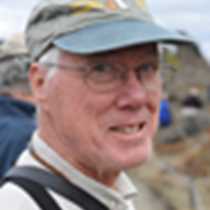Woodfjorden, northern Spitsbergen, Svalbard
Early morning fog brought an aura of mystery to the National Geographic Explorer as she turned into Woodfjord, a large fjord system way up in the north of Spitsbergen. We gazed out at Reindeer Flats, a large tundra plain, and found it still mostly covered with snow. One of the several possibilities for the morning was a walk ashore, but a polar bear was soon sighted from the bridge. White bear, white snow, and gray fog obscuring the landscape makes a bad combination. Discretion reigned, and we watched the distant bear as it devoured the remains of a seal. Another bear was sighted on shore-fast ice (the remnants of last winter's sea ice still attached to the land) far across the fjord, but it was impossibly far away ... or was it? We crossed the fjord to the edge of the ice, as the bear sat and watched us. It rose ... was it going into escape mode? Not at all. It approached us, closer and closer. We held our collective breath and it passed directly under the bow of our ship, paused to roll in the snow, and then, its curiosity satisfied, it ambled away with an unhurried gait. What an observation!
But we were far from done. Our afternoon was devoted to kayaking and Zodiac cruises near the Monacobreen Glacier (named for Albert I Grimaldi, Prince of Monaco, who charted the location of the glacier face in 1907). The morning fog had lifted and the water was glassy-smooth with beautiful reflections of the sharp peaks of Spitsbergen. A scout Zodiac reported a bear with a recently deceased bearded seal on the shore near the rotten fast ice of the fjord, with another bear nearby. Our Zodiacs went to investigate.
We ended up spending the afternoon, in three waves, as a fascinating scene of bear behavior unfolded. The old fellow shown above had made the kill and was feasting on the blubber. Nearby a much smaller bear, probably only recently independent from its mother, could only watch hungrily. Its every attempt to approach led to a charge from the large bear. With each charge the youngster made a hasty retreat. When the monarch, at last, could eat no more it moved away and collapsed into a post-meal nap (a concept that many of us can appreciate). Cautiously, the small bear approached and began to eat, always watching for signs of arousal from the sleeping bear.
Another small bear came from all the way across the fjord, first walking across the ice and then swimming through the ice-choked water. From their sharing of the kill, we judged this to be a sibling of the smaller bear, although the sharing was not without outbursts of sibling conflict (another familiar concept). Observers in the Zodiacs sat in perfect silence, interrupted only by the clicking of our cameras, as we took in this most incredible scene of bear behavior.
As long as there is Arctic ice, scenes such as we witnessed today will continue. Polar bears are consummate hunters of the northern ice and masters of the ice environment. Scientific research makes it clear that the northern ice is diminishing. This is not good for the polar bears (and for other animals such as walrus that depend on the ice). We have been fortunate to have wonderful interactions with each of these great animals. The lesson, I hope, is clear.




